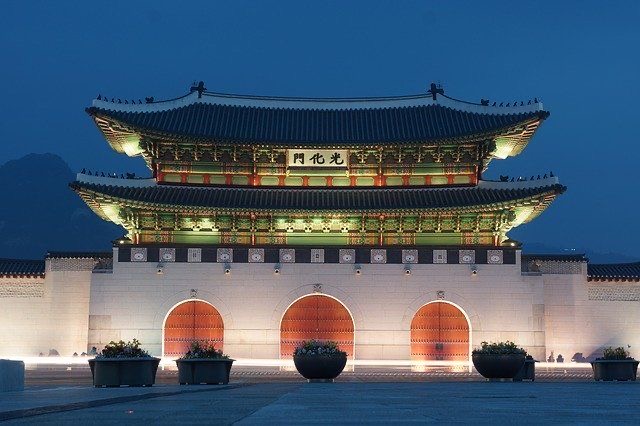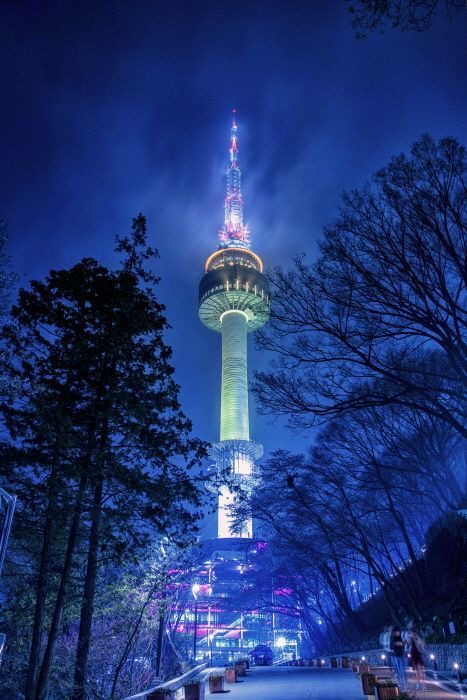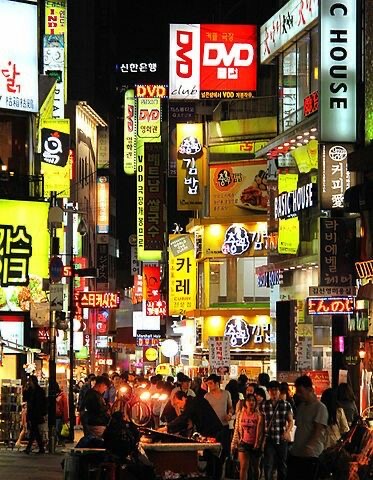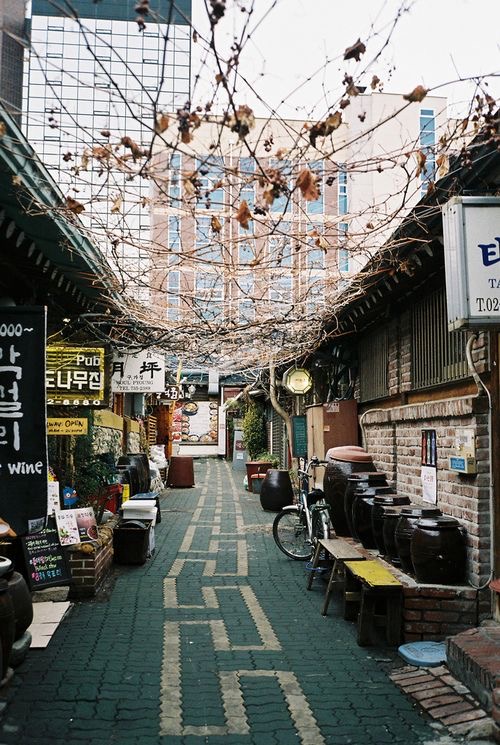Have you explored every nook and cranny of South Korea?
Have you explored every nook and cranny of South Korea?
Let's take a look at the top 5 places in Seoul that local residents and foreign tourists often visit.
Seoul is a representative tourist city in South Korea, attracting millions of foreign tourists every year. It is a unique city where tradition and modernity coexist. In addition to historical sites such as palaces, traditional markets, hanok villages, and folk villages, Seoul also boasts modern attractions such as Lotte World, COEX, and Digital Media City.
Furthermore, influenced by the Hallyu wave and K-pop, foreign tourists also enjoy experiencing Korean culture and art in Seoul. Based on these charms of Seoul, let's find out the characteristics of the local tourism market and the top 5 places that foreign tourists visit the most according to TripAdvisor.

Seoul's Top 5 Attractions
1. Gyeongbokgung Palace
Gyeongbokgung Palace is the primary royal palace and the most central among the palaces of the Joseon Dynasty, which was established in Seoul in 1395 after the capital moved to Hanyang.
The name "Gyeongbokgung" is derived from a phrase in the Book of Songs, which means "to seek great blessings." Although most of the palace was destroyed during the Japanese colonial period, it has been undergoing extensive restoration since 1990.
Gyeongbokgung Palace is located at 161, Sajik-ro, Jongno-gu, Seoul, a 5-minute walk from Exit 5 of Gyeongbokgung Station (Line 3). The admission fee for adults is 3,000 won, 1,500 won for children, and free for those under 24 years old, over 65 years old, disabled individuals, and veterans. Wearing a hanbok (Korean traditional clothing) allows free admission to Gyeongbokgung Palace.
When visiting Gyeongbokgung Palace, it is also recommended to explore the National Palace Museum of Korea and the National Folk Museum of Korea. The guided tours provided by the palace volunteers, who are fluent in Korean, English, Chinese, and Japanese, are highly recommended.
The tour schedules can be found on the official website. As Gyeongbokgung Palace is quite spacious, it is advisable to wear comfortable shoes and clothing and allocate sufficient time to fully experience the dignified and refined royal culture.
Please note that the opening hours may vary each month, so it is recommended to check the official website for the latest information. Gyeongbokgung Palace is closed on Tuesdays.

2. N Seoul Tower (Namsan Seoul Tower)
N Seoul Tower is a landmark and multi-cultural space representing Seoul. Located at the summit of Namsan Mountain (262m), it stands at a height of 236.7m. Completed in 1975, N Seoul Tower offers the best panoramic views of Seoul from its observation deck at an elevation of 479.7m. Since 2005, it has been promoted under the brand name "N Seoul Tower."
N Seoul Tower is situated at 105 Namsangongwon-gil, Yongsan-gu, Seoul. It can be accessed by various means such as walking, cable car, public transportation, or private vehicle. The operating hours vary each month, so it is recommended to check the official N Seoul Tower website for the latest information. It is open every day without any scheduled closures. The admission fee is 10,000 won for adults and 8,000 won for children, and there are also packages available that include the cable car.
N Seoul Tower offers a range of attractions and facilities. The N Seoul Tower Plaza is a multi-cultural space extending from the underground level to the ground floor, featuring attractions like the Teddy Bear Museum, Hello Kitty Island, Ssentoy Museum, and a shopping mall.
The observatory, located from the 2nd to the 5th floor, provides a breathtaking view of Seoul, including the Han River and Bukhansan Mountain. Additionally, there are various dining options, such as N Grill, a traditional Korean restaurant called Hanu Yukjeon Mun, and a pizza restaurant called THE PLACE Dining.
To enhance your visit to N Seoul Tower, you can choose from recommended courses such as the Family Course, Couple Course, Healing Course, or Sports & Leisure Course. You can also capture special moments at the photo zones or inquire about using the N Seoul Tower Square through the rental service.
N Seoul Tower is a romantic destination nestled in the heart of the city. Experience unforgettable moments in Seoul's center at N Seoul Tower.

3. Myeongdong
Myeongdong is a shopping and cultural mecca located in the heart of Seoul, attracting both domestic and international tourists. It has evolved into a shopping district since the 1970s and is now a complex space where you can enjoy various contents such as fashion, beauty, food, and culture.
Myeongdong is situated in Jung-gu, Seoul, and can be easily accessed on foot from Myeongdong Station on Line 4 or Euljiro-1(il)-ga Station on Line 2. The main shopping streets in Myeongdong are Myeongdong-gil and Myeongdong 8-gil, which are home to various shopping malls such as Lotte Department Store Main Branch, Noon Square, and Style Nanda Pink Hotel. You can also find specialty and souvenir shops, flea markets, and traditional markets in the area.
In Myeongdong, you can purchase clothing, cosmetics, and traditional Korean crafts that are worn or used by Korean celebrities.
Myeongdong offers a wide variety of restaurants and cafes. Famous street foods in Myeongdong include kalguksu (knife-cut noodles), mandu (dumplings), tteokbokki (spicy rice cakes), and dakgangjeong (crispy chicken). You can also enjoy Korean dishes like samgyeopsal (grilled pork belly), galbijjim (braised beef ribs), and haemultang (spicy seafood stew), as well as international cuisines like pizza, pasta, steak, Japanese dishes like sushi, ramen, udon, and Chinese dishes like jjajangmyeon (black bean noodles), tangsuyuk (sweet and sour pork), and jjamppong (spicy seafood noodle soup). In cafes, you can indulge in coffee and desserts or visit unique themed cafes like the Teddy Bear Museum, Hello Kitty Island, or cat cafes.
Myeongdong also has cultural and historical sites. Myeongdong Cathedral, completed in 1898, is the first Western-style stone building in Korea and is designated as a national cultural heritage. Many people visit Myeongdong Cathedral as a symbol of Korean Catholicism and a historic place. The Grévin Museum displays wax figures of world-famous personalities and is a great place for taking photos. The 3D Black Art Museum is a museum where you can appreciate and experience artworks created using three-dimensional special effects, making it a fun and enjoyable place to visit.
Myeongdong is a representative tourist destination in Seoul with diverse charms. Enjoy shopping, culture, and delicious food in Myeongdong while creating wonderful memories.

4. Bukchon Hanok Village
Bukchon Hanok Village is a neighborhood located in Jongno-gu, Seoul, known for its concentration of traditional hanok houses and a history spanning 600 years as the capital city.
Bukchon Hanok Village is situated between Gyeongbokgung Palace and Changdeokgung Palace, and during the Joseon Dynasty, it flourished as a residential area for the yangban class (nobles). Today, it is a living hanok village where people still reside, and it has gained popularity as a beloved tourist destination in Seoul, thanks to the rediscovery of the charm of hanok houses.
In Bukchon Hanok Village, you can experience various cultural activities such as visiting hanok galleries, traditional workshops, and hanok restaurants. You can also explore places like Bukchon Cultural Center, Bukchon Village Library, and Little Shelter Gallery. Bukchon Hanok Village is known for its "Bukchon 8 Views," which encapsulate the beautiful scenery and history of the area.
The Bukchon 8 Views are as follows:
- Gyedong-gil: The representative street of Bukchon Hanok Village, characterized by its blend of hanok houses and stone walls.
- Wonsodong Alley: Wonsodong Alley is home to Wonsogak, a stationery shop that was used by the royal family during the Joseon Dynasty.
- 31st Street in Gaehoe-dong: 31st Street in Gaehoe-dong is an area densely packed with hanok houses and was the residential area of the yangban class during the Joseon Dynasty.
- Changdeokgung Palace Rear Garden: Changdeokgung Palace Rear Garden is a garden that was frequented by the kings of the Joseon Dynasty and is designated as a UNESCO World Cultural Heritage site.
- Samcheong Park: Samcheong Park is a park located at the foot of Mount Bukhansan, offering a panoramic view of Seoul.
- Samcheong-dong Artist Street: Samcheong-dong Artist Street is a street where various artists' studios and galleries are gathered.
- National Folk Museum of Korea: The National Folk Museum of Korea showcases traditional Korean culture and lifestyle.
- Gyeongbokgung Palace: Gyeongbokgung Palace is a representative palace of the Joseon Dynasty, where you can catch a glimpse of Korean royal culture.
When visiting Bukchon Hanok Village, please adhere to the guidelines and practice "silent tourism." Since it is a living residential area, where people still reside, please refrain from making noise or littering. Additionally, group visits are limited to around 10 people.

5. Insadong
Insadong is a tranquil street located in Jongno-gu, Seoul, where you can enjoy traditional culture. The name "Insadong" is derived from the characters "In" (仁) from the former name of Hansungbu, a governmental office during the Joseon Dynasty, and "Sa" (寺) from Daesadong, meaning "temple."
During the early Joseon Dynasty, the area naturally became a hub of artistic activities with the establishment of painting studios here. Today, Insadong is a place where various forms of art and culture converge, including art galleries, traditional craft shops, antique stores, and workshops.
In Insadong, you can purchase tea and traditional crafts, enjoy street food and restaurants, attend exhibitions and performances, or simply relax on a hanok (traditional house) terrace. There are plenty of experiences to enjoy in Insadong, showcasing the charm of traditional culture.
Notable attractions in Insadong include Ssamziegil, a traditional culture shopping space; the only privately-run museum dedicated to wooden sculptures, Mokin Museum; Gallery LUX, a specialized photo gallery; Toto's Antique Shop, which displays nostalgic items; Gyeongin Art Museum, featuring traditional hanok art exhibitions and ateliers, and more.
When visiting Insadong, please adhere to the guidelines and practice "silent tourism." As it is a living residential area, where people still reside, please refrain from making noise or littering. Additionally, group visits are limited to around 10 people, and obtain permission for photography. Within shops, please avoid making excessive noise or smoking.
Characteristics of Seoul's Most Visited Tourist Attractions by Foreign Tourists
What are the characteristics of Seoul's most visited attractions by foreign tourists? These attractions share the following commonalities:
- Harmony of Tradition and Modernity: Seoul is a city where tradition and modernity coexist, and foreign tourists enjoy experiencing this contrast. For example, places like Gyeongbokgung Palace and Namsan Seoul Tower feature a blend of traditional and modern architecture. Additionally, Bukchon Hanok Village and Insadong offer traditional hanok houses and crafts alongside modern cafes and galleries.
- Diversity of Experiences and Culture: Seoul provides a diverse range of experiences and cultural offerings, which foreign tourists are eager to explore. For instance, Myeongdong is a place where visitors can enjoy shopping and food experiences. Moreover, tourists interested in Hallyu and K-pop often visit locations like SM Town COEX Artium or K-Star Road.
- Accessibility and Safety: Seoul is known for its accessibility and safety, which are important factors for foreign tourists. Most of Seoul's attractions can be easily reached by subway or bus. Additionally, Seoul is a city with a low crime rate and friendly people.
In conclusion, this analysis highlights the local tourism market in Seoul and identifies the most visited attractions by foreign tourists, along with their characteristics. Seoul offers a harmonious blend of tradition and modernity, diverse cultural experiences, and a safe and accessible environment. The local tourism market in Seoul has great potential for further growth.
Why not consider visiting each of Seoul's local attractions one by one?